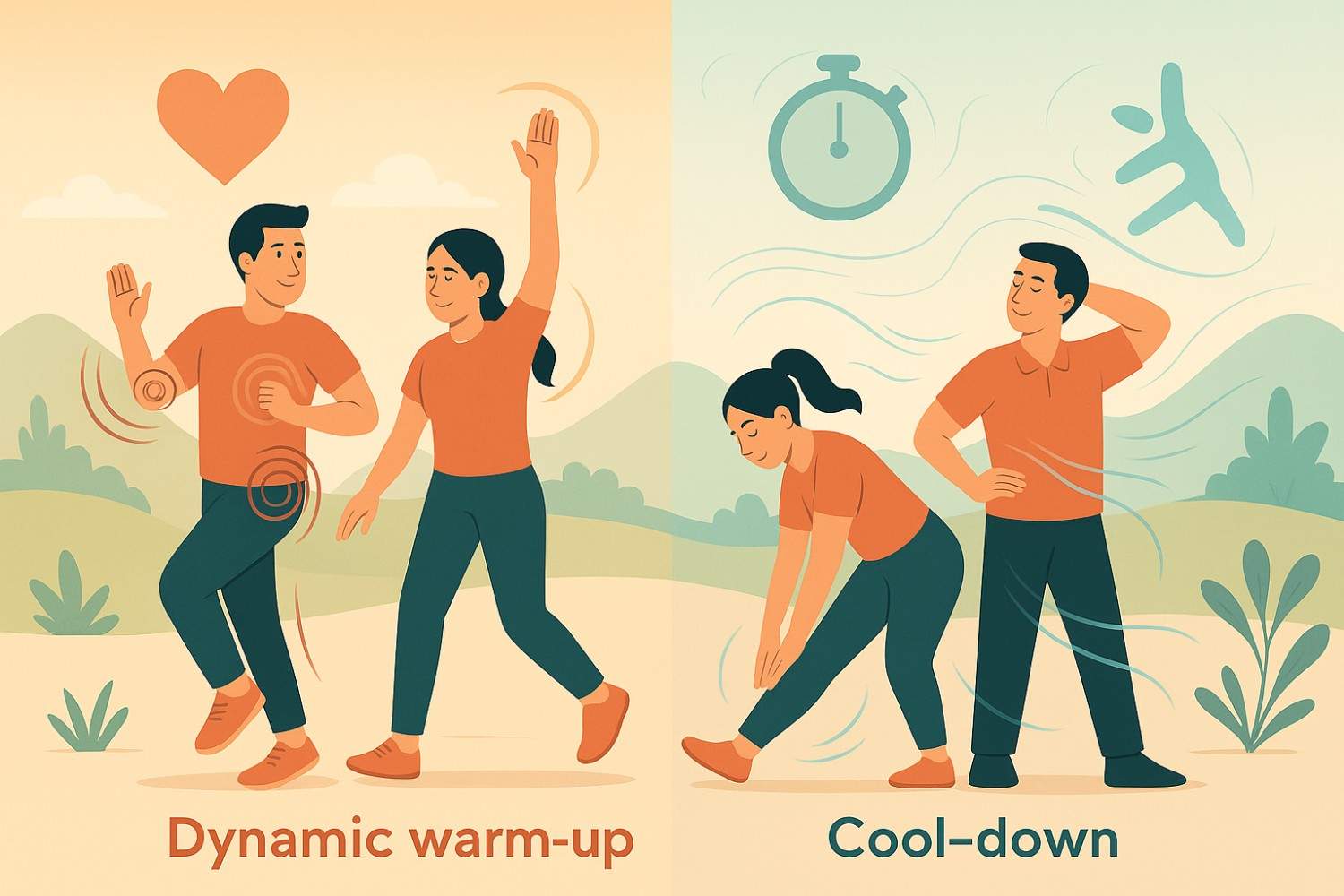Introduction
Most people know they should warm up before a workout and cool down afterward—but many still skip these essential components. Whether due to lack of time, motivation, or awareness, neglecting proper preparation and recovery can increase the risk of injury, delay muscle recovery, and reduce workout performance. From a physiotherapist’s perspective, warming up and cooling down aren’t optional extras—they’re critical pillars of a safe and effective fitness routine.
A well-structured warm-up primes your muscles, joints, and cardiovascular system for activity, while a proper cool-down helps prevent soreness, promotes circulation, and resets your body post-exercise. For both athletes and beginners, these practices ensure smoother, safer movement and faster recovery.
In this blog, we’ll explore the science behind warming up and cooling down, what each should include, and why physiotherapists emphasize their importance in every physical activity program.
✅ 1. The Science of a Warm-Up: Preparing the Body for Action
A warm-up is more than just light jogging or a few arm swings—it’s a gradual transition from rest to activity. Physiologically, it offers the following benefits:
- Increases blood flow to muscles
- Elevates muscle temperature, making them more elastic and less prone to strain
- Enhances nerve conduction, improving reaction time and coordination
- Stimulates synovial fluid in joints for better lubrication and mobility
- Prepares the cardiovascular system for exertion
Without this preparation, your body may be stiff, uncoordinated, and vulnerable to sudden stress, increasing the risk of sprains, tears, or cramping.
✅ 2. What Should an Ideal Warm-Up Include?
Physiotherapists recommend warm-ups tailored to the activity you’re about to perform. A good warm-up typically lasts 5–10 minutes and should include:
🔹 General Warm-Up
Start with low-intensity cardio such as:
- Brisk walking
- Jogging
- Jumping jacks
- Cycling
This raises heart rate and body temperature.
🔹 Dynamic Stretching
Unlike static stretching (holding a position), dynamic stretches involve movement and mimic your workout patterns:
- Arm circles
- Leg swings
- Hip openers
- High knees
- Torso twists
These movements improve range of motion and activate the nervous system.
🔹 Sport-Specific Drills
For athletes, warm-ups should also include light versions of the main activity, like dribbling for basketball or light shadowboxing for martial arts.
✅ 3. The Cool-Down: Easing Back to Baseline
After intense activity, abruptly stopping can cause blood to pool in the limbs, leaving you lightheaded or dizzy. A cool-down helps your body transition gradually from high exertion to rest. Its benefits include:
- Preventing blood pooling and fainting
- Reducing heart rate and breathing rate gradually
- Aiding in lactic acid removal, which reduces muscle soreness
- Promoting flexibility and muscle recovery
- Reducing the likelihood of post-exercise stiffness
Skipping this step may leave your muscles tight, fatigued, and more prone to post-exercise pain.
✅ 4. What Should a Cool-Down Include?
An effective cool-down lasts about 5–15 minutes, depending on the intensity of the workout.
🔹 Low-Intensity Cardio
Start with slow movements to lower heart rate:
- Walking in place
- Gentle cycling
- Deep breathing techniques
This helps normalize blood pressure and restore circulation.
🔹 Static Stretching
This is the time for holding stretches, focusing on the muscles just used:
- Hamstring stretch
- Calf stretch
- Quadriceps stretch
- Chest and shoulder stretch
- Neck stretches
Hold each stretch for 20–30 seconds without bouncing. Stretching during cool-down helps improve muscle flexibility and prevents tightness.
✅ 5. Why Physiotherapists Emphasize Warm-Up and Cool-Down
As movement specialists, physiotherapists often see injuries that stem from inadequate preparation or recovery. Common issues include:
- Muscle strains from sudden loading
- Joint stiffness due to poor mobility
- Delayed Onset Muscle Soreness (DOMS) from lack of proper cool-down
- Overuse injuries due to repetitive stress without counteractive recovery
In rehab programs, warm-ups are used to prepare tissues for therapeutic exercise, while cool-downs are essential for reducing flare-ups in chronic pain or inflammatory conditions.
✅ 6. Tips for Staying Consistent
- Schedule time for warm-up and cool-down—don’t treat them as optional.
- Use music or guided videos to stay engaged.
- Keep routines short and functional—it’s quality over quantity.
- If you’re unsure what’s right for your body, consult a physiotherapist for a personalized warm-up and cool-down plan.
Conclusion
Warm-ups and cool-downs are essential tools for enhancing performance, preventing injury, and promoting recovery. They prepare your body and mind for movement and restore balance afterward—especially important for those with existing musculoskeletal issues or high training loads.
As physiotherapists emphasize, skipping these steps might save you time now but could cost you later in the form of tightness, soreness, or injury. Whether you’re a weekend walker, professional athlete, or post-surgery patient, integrating proper warm-up and cool-down into your routine can make all the difference.
Move smarter, not harder—take those few extra minutes before and after your workout. Your body will thank you.
– Dr. Aprajeeta Chouhan, Assistant Professor
Faculty Of Physiotherapy, Madhav University

